Russia's housing market still depressed
The Russian housing market hasn’t recovered - despite appearances. Resale apartment prices rose 3.79% during the year to end-Q2 2011, according to the Federal State Statistics Service, but the kicker was inflation - resale apartment prices actually fell 5.25% when the price figures are adjusted for inflation.
- In Moscow resale apartment prices fell 5.38%, after inflation.
- In St. Petersburg resale apartment prices fell 15.23%, after inflation.
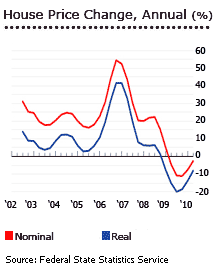
Rents are also declining. In March 2011, the average Moscow rent fell 2.7% y-o-y to RUB207,582 (US$6,439) per month, according to Knight Frank.
Moscow Mayor Sergey Sobyanin imposed a ban on residential construction inside the Third Transport Ring, the main access road to the capital’s business centre. As a result, new housing supply contracted by 18.1% y-o-y to H1 2011.
Russia had a massive housing boom from 2000 to 2007, with secondary market prices skyrocketing by 436% while primary market prices rose 362%. Property prices started to weaken in late-2008, and began falling in the second quarter of 2009.
House prices are still declining, though the rate of decline began to slow in 2H of 2010.
According to the Land Code of 2001, private ownership of land properties is allowed for both locals and foreigners. The legislation was extended to Moscow in January 2006.
The ruble’s recovery could help
Real estate transactions, purchases or leases in Russia are quoted and paid in US dollars. This means property prices and rents may move not because the value of the property has changed, but because the ruble has appreciated or depreciated.
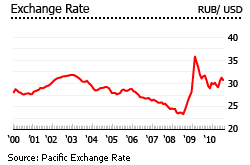
From the second half of 2008 to early 2009, the ruble depreciated sharply against the US dollar, from RUB23.36 in July 2008, to RUB35.82 per US dollar in February 2009. So those who had committed to buy or rent had to raise 50% more money, a cost increase which added pressure on the housing market, leading to its crash in 2009.
In July 2010, the average exchange rate stood at RUB30.76=US$1. According to the latest IMF Economic Outlook, the ruble is significantly undervalued—by 21% against the US dollar and 15% against the euro. The ruble is expected to rise over the next 6 to 12 months.
Rents stabilizing, but gross yields are down
The Russian elite rental market is already stabilizing. In March 2010, the average rent for elite apartments with a total area of 80 sq. m. to 150 sq. m. was US$6,615 (RUB201,548) per month, almost the same as last year, according to Knight Frank, though during this period supply grew 12.6%.
In June 2009, gross rental yields in Moscow’s upper-end areas were only 3.41%, on average – 1.62% lower than a year ago, according to Global Property Guide research. On the other hand, St. Petersburg apartments generate higher yields at around 6.9%, on average, though still lower by 1.57% than a year ago.
Moscow is among the world’s most expensive cities to live in for expatriates, according to the 2009 Mercer Cost of Living Survey. Rent payments are commonly in US dollars or euros, which can be paid on a monthly or quarterly basis.
Interest rates are falling
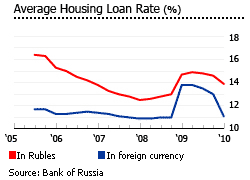
Average interest rates for ruble and foreign currency-denominated housing loans fell to 13.9% and 11.1%, respectively, in the first quarter of 2010. The central bank left its main interest rates unchanged in June 2010 – a signal after 14 consecutive months of interest rate cuts.
Russia’s massive housing boom (1998 -2007)
From 2000 to 2007, prices in Russia’s secondary market rose 436%, while primary market prices rose 362%.
- The Central Federal District (FD), which includes Moscow, registered the highest secondary market house price increases from 2000 to 2007, at 589%. Primary market prices rose 345% over the same period.
- In Northwestern FD, which includes St. Petersburg, house prices rose the least from 2000 to 2007: 338% for the secondary market and 293% for the primary market.
- In the primary market, Urals FD (593%), Siberian FD (507%), and Far Eastern FD (400%) experienced the fastest house price increases from 2000 to 2007. The increased mineral and fuel extraction from these districts partly explains the large price increases.
Despite the house price falls during the last 4 quarters, the ratio between per square metre prices and GDP per capita in Russia is still one of the highest in the world – always a danger signal.
| |
||||||
| |
||||||
| RUSSIA | |
|||||
| Central FD | |
|
|
|
||
| Northwestern FD |
|
|||||
| Southern FD | ||||||
| Far Eastern FD | ||||||
| Urals FD | ||||||
| Siberian FD | ||||||
| Volga FD | ||||||
| Source:Rosstat | ||||||
Russia’s economy emerges from recession
Russia’s GDP growth accelerated to 5.8% during the year to May 2010, and real incomes increased by more than 7%.
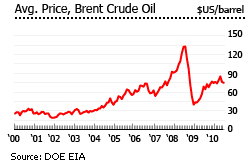
“We have very good start-up conditions for further upturn. That does not mean the crisis has been overcome, but the worst of the recession is over,” said Prime Minister Vladimir Putin.
Energy prices are rising again – good news for Russia, given its dependence on oil revenues.
Russia is the world´s leading natural gas exporter and the second leading oil exporter. In 2007 it was the world’s top oil producer, overtaking Saudi Arabia. It has the world´s largest natural gas reserves, the second largest coal reserves, and the 8th largest oil reserves.
Russia also has huge amounts of mineral reserves including platinum, nickel, aluminum, iron ore, copper gold and diamond. Oil, natural gas, metals, and timber account for more than 80% of Russian exports abroad. Revenues from oil and gas account for 50% of Russia’s budget.

Russia enjoyed outstanding average GDP growth of 6.8% per year from 1999 to 2008. However, commodity and energy prices plunged in the second half of 2008. Brent crude fell from US$132 per barrel in July 2008 to US$39.95 in December 2008. Brent crude has risen since then by 61%, to US$74.8 per barrel in June 2010
Inflation was 6% in April 2010, the lowest in 12 years, a decline attributable to a stronger ruble, a weaker euro, depressed consumer demand, and lower import prices. The country’s core inflation was 8.3% in 2009, a sharp decline from 13.6% in 2008, according to Bank of Russia. The Russian government aims to narrow the deficit to 3% by 2012, from a 5.9% deficit in 2009, the country’s first fiscal gap in a decade.
Medvedev’s “Russian Dream” housing program
One of the priorities of the Medvedev government is to move its citizens from apartment blocks to single-family homes. Over 77% of the country’s 142 million citizens now live in apartments.
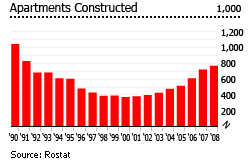
Similar to other transition economies, construction fell sharply in Russia during the late 1990s. Most Russians live in aging Soviet-era housing stock, particularly outside the main cities.
To realize its dream, the government has bought about 2.5 million acres of land. In 2011, at least 14 million sq. m. of housing are expected to be under construction, increasing to 20 million sq. m. in 2012. This is about 30% of all residential construction in the country.
Mortgage market is now getting state aid
Most Russian banks stopped making loans during the crisis, while others dramatically raised interest rates. Total outstanding housing loans fell 6.5% during the year-to-end-Q1 2010. 83% of these were in rubles, the remaining 17% in foreign currency.
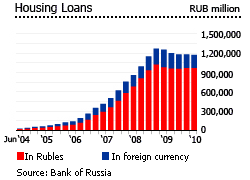
Only 14% of homes were bought using mortgages in 2007, and 26% of purchases of newly-constructed apartments, mostly higher-end homes. Most real estate transactions are done in cash and paid in full with US dollars. Buyers and sellers use banks simply to avoid being mugged while exchanging wads of dollar bills. Buyers reserve dollars days in advance.
Prime Minister Vladimir Putin has pledged to lower mortgage interest rates and down payments. In 2006, laws underpinning mortgage-backed securities were introduced, allowing banks to refinance housing loans for the first time. The state has now promised to provide financial aid totaling US$8.3 billion (RUB250 billion) to commercial banks to facilitate housing loans.